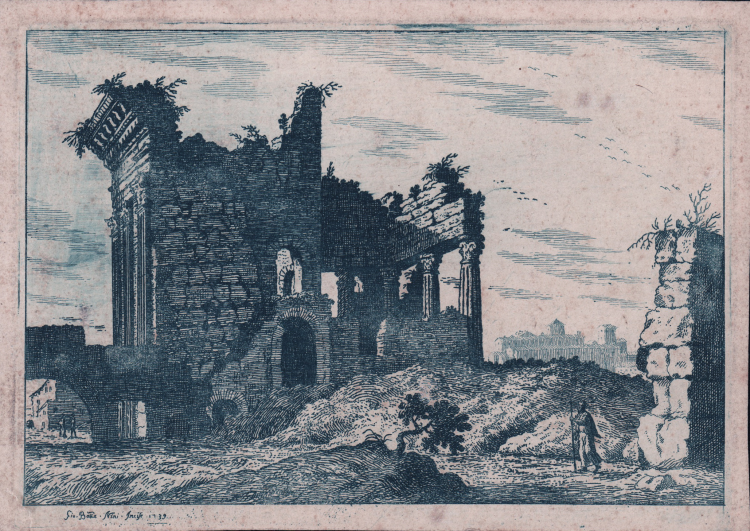



| Reference: | S42069 |
| Author | Giovanni Battista Nini |
| Year: | 1739 |
| Measures: | 164 x 118 mm |


| Reference: | S42069 |
| Author | Giovanni Battista Nini |
| Year: | 1739 |
| Measures: | 164 x 118 mm |
Etching, 1739, signed and dated in plate at lower left.
Beautiful proof, printed in blue ink on contemporary laid paper, with margins, in excellent condition.
Youthful work of the painter, sculptor and engraver on glass of Urbino origin, Giovan Battista Nini (1717-1786). Nini moved at an early age to Bologna, where in 1735 he was among the members of the Accademia Clementina. It was in Bologna that he began to become familiar with clay, with mixtures, with mixtures of different materials and to experiment with the best mixture for his compositions, with which he would later create a large series of portrait medallions. His first landscapes date back to this early Bolognese phase. Although their layout follows the great models of seventeenth-century tradition (Poussin, Dughet, Claude, but also Magnasco, Marco Ricci and Salvator Rosa), they respond to a principle of order, balance and truth that at times verges on the picturesque.
Rare.
Bibliografia
Anna Cerboni Baiardi, Barbara Sibille, Giovan Battista Nini (1717-1786) Da Urbino alle rive della Loira. Paesaggi e volti europei, Urbino 2001; Thieme-Becker, Künstler-Lexikon, XXV, Lipsia 1931.
Giovanni Battista Nini (1717-1786)
|
Painter, sculptor, engraver on glass, born in Urbino April 10 (19) 1717, died in Chaumont-sur-Loire May 2, 1786. After a brief stay in Verona, Nini went to Spain, where in Madrid in 1747 signed an illustrated alphabet, and is employed in the Real Fábrica of crystals. Tried for the theft of a few pounds of mercury and, more seriously, for heresy, he was arrested in 1755 and stripped of all his possessions. Acquitted of the latter charge after two years in jail, Nini decided to move to France, where the artist began to produce his terracotta medallions. The series of portraits can be distinguished in two periods, corresponding to as many typologies. Between 1762 and 1766 there are the medallions, often without inscription, in which the figure is almost always represented up to shoulder height, inserted in the center of the roundel, enclosed by a mostly wavy border that gives the whole a sense of lightness and grace all Rococo. Around 1766 Nini developed to the extreme the formal solutions that he had already adopted previously in some portraits: the wavy border was replaced by a plain border, the face was replaced by a half-length bust; the figure expanded inside the medallion, acquiring greater importance. The growing dimensions of the image, the constant interest in the expressive rendering of the faces, the definition of the rank of belonging correspond to a progressive conquest of the individual characteristics of the characters. This leads to some exemplary portraits such as those of Benjamin Franklin, a friend of Jacques-Donatien Leray de Chaumont, who commissioned the Urbino artist to organize the work in his crystal and ceramics factory. And it was in the castle of Chaumont that Nini ended his days on May 2, 1786.
|
Giovanni Battista Nini (1717-1786)
|
Painter, sculptor, engraver on glass, born in Urbino April 10 (19) 1717, died in Chaumont-sur-Loire May 2, 1786. After a brief stay in Verona, Nini went to Spain, where in Madrid in 1747 signed an illustrated alphabet, and is employed in the Real Fábrica of crystals. Tried for the theft of a few pounds of mercury and, more seriously, for heresy, he was arrested in 1755 and stripped of all his possessions. Acquitted of the latter charge after two years in jail, Nini decided to move to France, where the artist began to produce his terracotta medallions. The series of portraits can be distinguished in two periods, corresponding to as many typologies. Between 1762 and 1766 there are the medallions, often without inscription, in which the figure is almost always represented up to shoulder height, inserted in the center of the roundel, enclosed by a mostly wavy border that gives the whole a sense of lightness and grace all Rococo. Around 1766 Nini developed to the extreme the formal solutions that he had already adopted previously in some portraits: the wavy border was replaced by a plain border, the face was replaced by a half-length bust; the figure expanded inside the medallion, acquiring greater importance. The growing dimensions of the image, the constant interest in the expressive rendering of the faces, the definition of the rank of belonging correspond to a progressive conquest of the individual characteristics of the characters. This leads to some exemplary portraits such as those of Benjamin Franklin, a friend of Jacques-Donatien Leray de Chaumont, who commissioned the Urbino artist to organize the work in his crystal and ceramics factory. And it was in the castle of Chaumont that Nini ended his days on May 2, 1786.
|